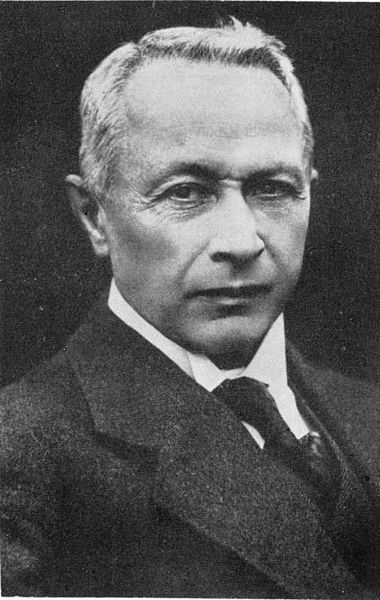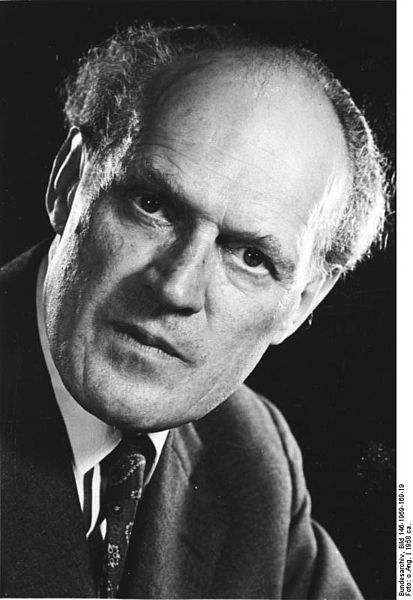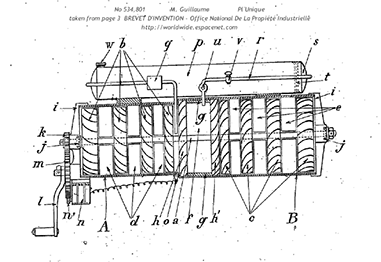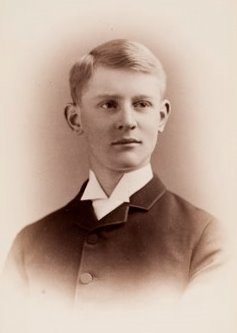<Back to Index>
- Engineer Hugo Junkers, 1859
- Aircraft Designer and Manufacturer Wilhelm Emil "Willy" Messerschmitt, 1898
- Inventor Maxime Guillaume, 1800+
- Physicist Edgar Buckingham, 1867
PAGE SPONSOR

Hugo Junkers (3 February 1859 – 3 February 1935) was an innovative German engineer, as his many patents in varied areas (gas engines, aeroplanes) show. In 1915, he pioneered the first great change in aviation materials and design technology, away from wood and fabric materials braced by wire rigging, towards all metal, cantilever - winged monoplane aircraft that had little to no external bracing.
Hugo Junkers is mainly known in connection with aircraft bearing his name. This includes such he reluctantly developed for the German Empire during World War I, later in minor association with Anthony Fokker, as well as civil aircraft designs during the Interwar Period produced by Junkers Flugzeugwerke (Junkers Aircraft Works). Junkers, a pacifist and not on good terms with the Nazis, died in 1935 and was not involved in the development of Junkers military aircraft for the Third Reich's Luftwaffe before or during World War II.
Born in Rheydt, Rhine Province, Junkers studied in Charlottenburg and Aachen.
He was a professor of mechanical engineering at Aachen between 1897 and
1912. Working as an engineer, Junkers devised, patented and exploited
gas engines, heaters, a calorie meter and other inventions.
His aeronautical work began in earnest only at the age of fifty. He had far seeing ideas of metal aeroplanes and flying wings, but always realities of war dragged him back. During World War I the government forced him to focus on aircraft production. In 1915, he developed the world's first practical all metal aircraft design, the Junkers J 1 "Blechesel" (Sheetmetal Donkey), which survived on museum display in Berlin until World War II, and later in 1918 his firm created the world's first low - winged single seat fighter aircraft, the Junkers D.I. However, the D.I. did not enter production until 1918. He also produced a two seat fighter (pilot and rear gunner), the Junkers CL.I. and an armored fuselage two seat all metal sesquiplane, the Junkers J.I, considered the best German ground attack aircraft of the war. The J.I's pattern of an armored fuselage that protected the nose mounted engine, pilot and observer in a unitized metal "bathtub", was the possible inspiration for Sergei Ilyushin's later IL-2 Shturmovik (conceivably appropriate as Junkers did have a manufacturing plant in Fili, a suburb of Moscow, in the Soviet Union in the 1920s) with a similar armored fuselage design, and Soviet aviation pioneer Andrei Tupolev and American aviation designer William Stout each owed much to Hugo Junkers in the designs of their earlier aircraft, which benefited from Junkers' corrugated light metal construction philosophy.
The Junkers F.13 from 1919 was the first of several successful civil aircraft designs of Junkers Flugzeugwerke
including the Junkers Ju 52/3m
from 1932. Through a variety of business initiatives Junkers was also
active in founding and developing airlines around the globe initially
aiming to sell its aircraft. Airlines where Junkers played a pivotal
role in early phases of their development include Deutsche Luft Hansa
and Lloyd Aéreo Boliviano.
However, several business ventures failed from wider economic or
political problems that hamstrung sound engineering plans. But Junkers
always had more ideas: the massive four engined G.38,
nicknamed "Der Grosse Dessauer", delivered to Luft Hansa made no
commercial trips for many months as he repeatedly recalled it to the
factory for improvements.
Junkers was a socialist and a pacifist. For these reasons, he had several occasions to cross swords with German leadership. In 1917 the government forced him into partnership with Anthony Fokker to ensure wartime production targets would be met.
During the 1920s in Germany and among Junkers' employees a wide spectrum of political views was present. About every aspect of the business, and of its environment, there were differing opinions. For members of all the many groups represented in Junkers, aviation offered hope for national renewal. Their varied views led to lively internal corporate politics. In 1926, unable to make government loan repayments after a failed venture to build planes for the USSR, he lost control of most of his businesses.
In 1933 the new Nazi
government interfered and, on taking power, immediately demanded
ownership of Junkers' patents and control of his remaining companies.
Under threat of imprisonment he eventually acquiesced, to little avail; a
year later he was under house arrest; a year after that he was dead.

Wilhelm Emil "Willy" Messerschmitt (June 26, 1898 – September 15, 1978) was a German aircraft designer and manufacturer. He was born in Frankfurt am Main, the son of a wine merchant. His stepfather was the American painter and Munich Academy Professor Carl von Marr.
Probably Messerschmitt's single most important design was the Messerschmitt Bf 109, designed in 1934 with the collaboration of Walter Rethel. The Bf 109 became the most important fighter in the Luftwaffe as Germany re-armed prior to World War II. To this day, it remains the most produced fighter in history, with some 35,000 built. Another Messerschmitt aircraft, first called "Bf 109R", purpose built for record setting, but later re-designated Messerschmitt Me 209, broke the absolute world air speed record and held the world speed record for propeller driven aircraft until 1969. His firm also produced the first jet-powered fighter to enter service — the Messerschmitt Me 262, although Messerschmitt himself did not design it.
As a young man, Messerschmitt befriended German sailplane pioneer Friedrich Harth. Harth joined the German army in 1914 and while he was away at war, Messerschmitt continued work on one of Harth's designs, the S5 glider. In 1917, Messerschmitt himself signed up for military service. Following the war, the two were re-united and continued to work together while Messerschmitt commenced study at the Munich Technical College and Harth built aircraft at the Bayerische Flugzeugwerke (BFW - Bavarian Aircraft Works). The S8 glider they designed and built together in 1921 broke a world duration record (albeit unofficially) and they went into partnership for a while running a flying school. The same year, the first plane entirely designed by Messerschmitt flew — the S9 glider.
During 1923 Harth and Messerschmitt had a falling out and went their
separate ways, with Messerschmitt founding his own aircraft company at
Augsburg. At first, Messerschmitt built sailplanes, but within two years
had progressed via motor gliders to small powered aircraft - sports and
touring types. These culminated in the Messerschmitt M 17 and
Messerschmitt M 18 designs, which Messerschmitt sold to BFW in 1927,
when the Bavarian state government encouraged a merger between the two
companies. These were followed by the Messerschmitt M20 light transport in 1928, which proved a disaster for BFW and Messerschmitt himself. Two Deutsche Luft Hansa
M20s were involved in serious crashes very soon after purchase, and
this led the airline to cancel their order for the type. This caused a
serious cash flow problem for the company and led to its bankruptcy in
1931. The M20 crashes also created a powerful enemy for Messerschmitt in
the person of Erhard Milch, the head of Luft Hansa who had lost a close friend in one of the crashes.
The establishment of the Reichsluftfahrtministerium ("Reich Aviation Ministry" - RLM) by the Nazi government in 1933, headed by Milch, led to a resurgence in the German aircraft industry and the resurrection of BFW. Collaborating with Robert Lusser, Messerschmitt designed the flagship product of the relaunched company, a low wing sports monoplane called the Messerschmitt M37, but better known by its later RLM designation of Bf 108 Taifun. The following year, Messerschmitt would incorporate many design features of this aircraft into the Bf 109 fighter.
Nevertheless, only the ties that Messerschmitt had formed with leading Nazis Rudolf Hess and Hermann Göring (through Theo Croneiss) saved him from sharing the fate of Milch's other great enemy, Hugo Junkers. To stay in business in the face of Milch ensuring that he would get no government contracts, Messerschmitt had signed agreements with Romania for sales of the M37 and a transport plane, the Messerschmitt M 36. When Milch learned of this, he publicly denounced Messerschmitt as a traitor, and the Gestapo was sent to question him and other BFW officials. Probably due to Croneiss' intervention, no further action was taken.
When in 1936, the Messerschmitt Bf 109 won the RLM's single seat fighter contest to become one of the main Luftwaffe aircraft types, Messerschmitt and his factory took an important role in the RLM's armament plans, increasing in significance even further when Messerschmitt's Bf 110 also won the multi - purpose fighter contest.
On July 11, 1938, Messerschmitt was appointed chairman and managing
director of Bayerische FlugzeugWerke (BFW) and the company was renamed
after him to Messerschmitt AG. This
same year, the company began work on what would eventually become the Me
262, and of the Messerschmitt Me 210,
planned as successor for the Bf 110. The Me 210 turned out to be
plagued by massive development problems that were only solved by
evolving the type into the Messerschmitt Me 410, and the resulting
problems and delays again put the reputation of both Messerschmitt and
his namesake company in jeopardy.
Following World War II, Messerschmitt was tried by a denazification court for using slave labor, and in 1948 was convicted of being a "fellow traveler". After two years in prison, he was released and resumed his position as head of his company. Since Germany was forbidden to manufacture aircraft until 1955, he turned his company to manufacturing prefabricated buildings, sewing machines, and small cars - most notably the Messerschmitt Kabinenroller. Exporting his talents, he designed the Hispano HA-200 jet trainer for Hispano Aviación in Spain in 1952 before eventually being allowed to return to aircraft manufacturing in Germany to license produce the Fiat G91 and then Lockheed F-104 Starfighter for the West German Luftwaffe. He designed the later Helwan HA-300, a light supersonic interceptor, for the Egyptian air forces. This is his last aircraft design.
Messerschmitt saw his company through mergers first with Bölkow in 1968 and then Hamburger Flugzeugbau in 1969, at which point it became MBB (Messerschmitt - Bölkow - Blohm, now part of EADS) with Messerschmitt as chairman until 1970 when he retired. He died eight years later, on 15th September 1978 in a Munich hospital in undisclosed circumstances.
Messerschmitt's designs were characterized by a clear focus on performance, especially by striving for lightweight construction, but also by minimizing parasitic drag from aerodynamic surfaces. His critics accused him of taking this approach too far in some designs. His falling out with Harth had been over designs Harth felt to be dangerously unstable, and the Me 210 displayed instability, too, which could only be cured by enlarging the airframe and the aerodynamic surfaces, increasing drag and weight. Messerschmitt's design philosophy also is evident in his arguments with Alexander Lippisch, who was designing the tailless Me 163 rocket fighter for production at the Messerschmitt works. While Lippisch maintained the tailless design on principle had an advantage with regard to total drag, Messerschmitt pointed out that the design compromises necessary to make a tailless aircraft safely controllable defeated this purpose by increasing drag to the original level and above.
Messerschmitt was appointed an Honorary Professor by the Munich Technical College in 1930, and the Vice President of the Deutsche Akademie für Luftfahrtforschnung (German Academy of Aeronautical Research). The German government also awarded him the title of Wehrwirtschaftsführer (defense industry leader). In 1938, Adolf Hitler bestowed upon Messerschmitt the German National Prize for Art and Science.

In aerospace, Maxime Guillaume held a French patent for a turbojet engine in 1921.
The first patent for using a gas turbine to power an aircraft was filed in 1921 by Frenchman Maxime Guillaume.
His engine was to be an axial flow turbojet, but was never constructed,
as it would have required considerable advances over the state of the
art in compressors.

Edgar Buckingham (July 8, 1867 Philadelphia, PA – April 29, 1940 Washington DC) was a physicist.
He graduated from Harvard with a bachelor's degree in physics in 1887. He did additional graduate work at the University of Strasbourg and the University of Leipzig, where he studied under chemist Wilhelm Ostwald. Buckingham received a PhD from Leipzig in 1893. He worked at the USDA Bureau of Soils from 1902 to 1906 as a soil physicist. He worked at the (US) National Bureau of Standards (now the National Institute of Standards and Technology, or NIST) 1906 - 1937. His fields of expertise included soil physics, gas properties, acoustics, fluid mechanics and blackbody radiation. He is also the originator of the Buckingham π theorem in the field of dimensional analysis.
In 1923, Edgar Buckingham published a report which voiced skepticism that jet propulsion would be economically competitive with prop driven aircraft at low altitudes and at the speeds of that period.
Buckingham's first work on soil physics is on soil aeration, particularly the loss of carbon dioxide from the soil and its subsequent replacement by oxygen. From his experiments he found that the rate of gas diffusion in soil was not dependent significantly on the soil structure, compactness or water content of the soil. Using an empirical formula based on his data, Buckingham was able to give the diffusion coefficient as a function of air content. This relation is still commonly cited in many modern textbooks and used in modern research. The outcomes of his research on gas transport were to conclude that the exchange of gases in soil aeration takes place by diffusion and is sensibly independent of the variations of the outside barometric pressure.
Buckingham then work on soil water, research for which he is now renowned. Buckingham’s work on soil water is published in Bulletin 38 USDA Bureau of Soils: Studies on the movement of soil moisture, which was released in 1907. This document contained three sections, the first of which looked at evaporation of water from below a layer of soil. He found that soils of various textures could strongly inhibit evaporation, particularly where capillary flow through the uppermost layers was prevented. The second section of Bulletin 38 looked at the drying of soils under arid and humid conditions. Buckingham found evaporative losses were initially higher from the arid soil, then after three days the evaporation under arid conditions became less than under humid conditions, with the total loss ending up greater from the humid soil. Buckingham believed this occurred due to the self mulching behavior (he referred to it as the soil forming a natural mulch) exhibited by the soil under arid conditions.
The third section of Bulletin 38 contains the work on unsaturated flow and capillary action for which Buckingham is famous. He firstly recognized the importance of the potential of the forces arising from interactions between soil and water. He called this the capillary potential, this is now known as the moisture or water potentialmatric potential. He combined capillary theory and an energy potential in soil physics theory, and was the first to expound the dependence of soil hydraulic conductivity on capillary potential. This dependence later came to be known as relative permeability in petroleum engineering. He also applied a formula equivalent to Darcy's law to unsaturated flow.